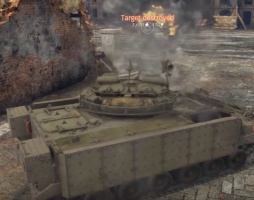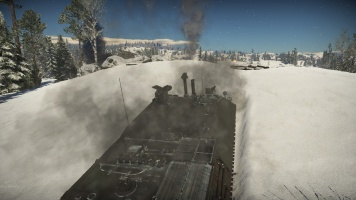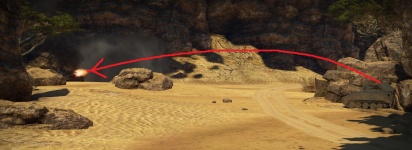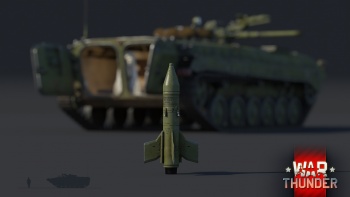Difference between revisions of "Anti-tank guided missiles"
bangerland (talk | contribs) (I might be historically inaccurate, but i thought that certain understanding, that not all ATGM carriers are same is necessary. Not sure if to write it from game perspective or w/e.) |
Jareel_Skaj (talk | contribs) (→See also: Sorted alphabetically, added Mortars) |
||
| (24 intermediate revisions by 8 users not shown) | |||
| Line 2: | Line 2: | ||
[[File:M551Sheridan History MGM51Shillelagh Firing.jpg|x250px|thumb|right|A [[M551|M551 Sheridan]] fires an anti-tank Shillelagh missile.]] | [[File:M551Sheridan History MGM51Shillelagh Firing.jpg|x250px|thumb|right|A [[M551|M551 Sheridan]] fires an anti-tank Shillelagh missile.]] | ||
| − | '''Anti-tank Guided Missile''' ('''ATGM'''), or simply ''' | + | '''Anti-tank Guided Missile''' ('''ATGM'''), or simply '''anti-tank missile''', refers to a missile system specialized in destroying heavily armoured vehicles such as tanks. |
__TOC__ | __TOC__ | ||
| Line 12: | Line 12: | ||
The defining terms between a "rocket" and a "missile" is the presence of a guidance system on the warhead. A rocket flies by its trajectory and once released, is free to fall wherever it lands. A missile on the other hand has access to computer technology to send the guided warhead wherever the operator desires with the usage of a joystick or a laser sight. | The defining terms between a "rocket" and a "missile" is the presence of a guidance system on the warhead. A rocket flies by its trajectory and once released, is free to fall wherever it lands. A missile on the other hand has access to computer technology to send the guided warhead wherever the operator desires with the usage of a joystick or a laser sight. | ||
| − | == | + | ==Usage of ATGM in-game== |
| − | + | [[File:Warrior sneak attack on tank.JPG|x200px|thumb|right|A Warrior utilizing its missile to destroy an enemy in front of it.]] | |
| + | |||
| + | In Arcade Mode, all ATGM launchers use the second-generation guidance system. Thus, once fired, keep the cross hair on the desired target to lead the missile. Keep in mind the missile trajectory as it has a very sensitive fuse so make sure it does not prematurely explode on a piece from the environment. | ||
| − | + | In Realistic and Simulator Modes, missile systems use the guidance system they are equipped with in real life. Thus, first and second-generation of the guidance system exist in-game. First generation guidance system require input from the tank movement keys to manually guide the missiles to the target. This guidance system is very jittery and is not very accurate. | |
| − | + | ===Guidance System=== | |
| − | * | + | * First-Generation: Also known as MCLOS, this missile requires manual input from the controller to control it. Use the default movement keys WASD to move the missile. A to steer left, D to steer right, W to steer down and S to steer up. Note that while you are controlling the missile, you will not be able to move from your firing position so make sure you are in a safe place. |
| − | * | + | * Second-Generation: Also known as SACLOS, this is a lot simpler than MCLOS. The missile is automatically guided by your crosshair sights and will adjust accordingly if you move your aiming reticle, so your vehicle is no longer forced to stand in place after firing the missile. So hold your crosshair onto your target as the missile flies into the air to score a hit. Alternatively, you can override the automatic system by aiming at something the missile has already passed to control the missile manually with your crosshair movement. This allows the vehicle to aim the missile at targets it cannot see. |
| − | == | + | ===[[:Category:ATGM_vehicles|Vehicles able to be equipped with ATGMs]]=== |
| − | + | ===Different launch methods=== | |
| + | Every nation had their own big idea of what ATGM equipped vehicle must be able to do, and as such, different vehicle designs were created, some being more specialized, than the others. Here is a list of certain specializations, that are currently in the game: | ||
| + | [[File:RPZ2 snipe.jpg|x200px|thumb|right|A Raketenjagdpanzer 2, with its raised optic and missile platforms, allowing it to target and engage enemies by only peeking over a raised position.]] | ||
| − | + | * '''Direct attack launchers''': These ATGM are standard and are fired straight out the launch tubes. These can be seen as supplementary weapons (such as on the [[Warrior]]) or as dedicated ATGM-launching vehicles (such as the [[RakJPz 2]]). Missile characteristics are quite diverse in this attack method, but usually possess very high launch speed, penetration values and/or post-penetration damage, though how much better would depend in the launcher vehicle's position in the matchmaking. However, the dedicated ATGM vehicles tend to have higher range and speed than the rest of its contemporaries. Some dedicated launchers even have design perks in term of optic and missile placement being higher than the hull body to make the most of a hull-down position | |
| − | + | [[File:Striker VerticalAttack BehindCover.jpg|x150px|thumb|right|A Striker using its missile's upward launch trajectory to surprise an enemy behind cover.]] | |
| − | |||
| − | * '' | + | * '''Upward attack launchers''': Prior to the development of 3rd-generation missiles, one characteristic burdened on the ATGM users is that to guide the missile, the user must remain exposed to maintain visual target to guide the missile onto target. This leaves the user very vulnerable and open to fire. One solution to this problem was a change in firing method. Instead of firing in a straight trajectory, the missile would have an upward launch motion to clear any obstructions in front, like cover for the vehicle. This can be seen in vehicles like the [[Strv 81 (Rb.52)]] and [[Striker]] designs, with the missiles aligned upwards to clear any cover protecting the vehicle. These missiles over distance eventually level out back into a straight trajectory, however if the target is close enough before this happens, one may exploit the flight pattern to perform a top-down attack onto the enemy's weaker roof armour and hit the enemy while they're behind cover. Higher generation missiles of this kind are more manoeuvrable, can speed up to acceptable level over time, and use tandem-charge to negate ERA effects. |
| − | + | * '''Hybrid tank technology''': The problem with missiles on vehicles is the inherent specialization the vehicle is required to have to make use of the weapon. As time went, technology became more and more fledged out, and so attempts on merging ATGM and tanks to produce the best of the two types of vehicle as a hybrid. One of the earlier tank hybrids was [[M551]]. The idea was to launch ATGM right out of cannon barrel, and then guide it with gunner's optics. As a more modern pieces of technology, these ATGMs are generally the fastest out there and can be launched on move at any speed, and with that they are able to compete with dedicated ATGM launchers, but force longer reload time. In the game, this kind of technology is mostly used by BR 9.0 and higher US and USSR tanks, mainly against hostile close air support and far away targets, attacking which with APFSDS would take too much time. For example: tanks like [[XM-803]] and [[T-80B]] can use them to fight against helicopters and lighter vehicles from afar. | |
| − | |||
| − | |||
| − | |||
| − | |||
| − | |||
| − | |||
| − | |||
| − | |||
| − | |||
| − | |||
| − | |||
| − | |||
| − | |||
| − | |||
==History== | ==History== | ||
===Initial Start-up=== | ===Initial Start-up=== | ||
| − | The first guided missile of its kind was created by Nazi Germany with the Ruhrstahl X-4 wire-guided air-to-air missile in 1944.<ref name=HoggSmartWeapon>Hogg 1997, ''Chapter Six: The Smart Weapons''</ref> The X-4 lead to the predecessor of the ground-attack missile in the X-7 variant, nicknamed | + | The first guided missile of its kind was created by Nazi Germany with the Ruhrstahl X-4 wire-guided air-to-air missile in 1944.<ref name="HoggSmartWeapon">Hogg 1997, ''Chapter Six: The Smart Weapons''</ref> The X-4 lead to the predecessor of the ground-attack missile in the X-7 variant, nicknamed Rotkäppchen ("Red Riding Hood"). Neither of these missiles saw operational service in World War II before it ended. After World War II, the interest in missile stagnated in the Allies except to the French. France was the first to produce an anti-tank missile; named the Nord SS.10 and it was introduced to the export market in 1955.<ref name="HoggSmartWeapon" /> The missile was very successful, procured by America and the Israelis and was cost-effective, costing only £350 per missile. 30,000 missiles were produced by 1962. However, it was far from a perfect missile as it only had a range of 1.6 km and a longer effective range was desired. Later in the 1950s, better missiles were produced in all sides of the Cold War. The French followed up with the SS.11, with upgraded lethality and range. The British adopted the Australian Malkara and the Vickers Vigilant missiles, both respectable weapons of the era. The Soviets developed the 3M6 Shmel (AT-1 Snapper), though it seemed to be inspired from the SS.10 design.<ref name="HoggSmartWeapon" /> All these missiles followed a trend of being portable enough to be used by an infantry crew, yet powerful enough to destroy any tank of the time of introduction, which these missiles succeeded in. However, a problem arose in the guidance systems. |
===Guidance System=== | ===Guidance System=== | ||
| − | The first missiles that came to be used the | + | The first missiles that came to be used the first-generation guidance system known as "Manual command to line of sight" (or MCLOS). The missile, once in flight, require the operator use a controller such as a joystick to steer the missile into the target.<ref name="HoggSmartWeapon" /> This was a troublesome system as it requires the operator to keep the missile sight on target while manually inputting the correction to the missile course, which was often not precise enough to allow for accurate aiming. This guidance system also left the operator exposed as the missile took its course, to the point that a counter to it was for tanks to simply bombard the position or kill the operator to disrupt the missile guidance. Most of the early missile systems like the SS.11, Malkara, and Shmel were based on this guidance system.<ref name="HoggSmartWeapon" /> |
| − | The | + | The second-generation guidance system was the "Semi-automatic command to line of sight" (or SACLOS). Unlike the first generation, this requires the operator to simply keep the missile sights onto the target and the missile will correct itself through radio or wire signals.<ref name="HoggSmartWeapon" /> Another system used in this format was a laser sight or a camera view from the war head for a more direct sighting and aiming. This system was a lot simpler to use than the first generation, though still left the operator stationary and vulnerable. SACLOS made up the majority of missile designs used during later half of the Cold War, from the Soviet 9M14 Malyutka (AT-3 Sagger), the British Swingfire, the American AGM-114 Hellfire, and the BGM-71 TOW. |
| − | The | + | The third-generation guidance system is the most sophisticated and modern of the missile systems. Using a laser or an IR sight to find a target in any environment, the missile uses a "fire-and-forget" system that allows for the operator to move from his position right after the missile is fired.<ref name="HoggSmartWeapon" /> This missile gives the operator a greater degree of safety than the others and can be found in most modern missile launchers, such as the FGM-148 Javelin in U.S. inventory. |
===Impact of Missiles to Tank Development=== | ===Impact of Missiles to Tank Development=== | ||
| Line 68: | Line 57: | ||
Of course, with new protection, comes new ways of destroying that protection. Missile designers use a variety of ways to defeat the new armour such as the tandem-charge, which uses two HEAT rounds in one missile by using the first one to destroy the protection above the base armour like ERA and the second will attack the base armour straight-on. In response, ways to fight missiles by disrupting their guidance system also began such as electronic jammers, active protection systems, and smoke screens. Nevertheless, the missiles remain a large threat against armoured forces as it gives the infantry a cheap weapon able to destroy an expensive tank. | Of course, with new protection, comes new ways of destroying that protection. Missile designers use a variety of ways to defeat the new armour such as the tandem-charge, which uses two HEAT rounds in one missile by using the first one to destroy the protection above the base armour like ERA and the second will attack the base armour straight-on. In response, ways to fight missiles by disrupting their guidance system also began such as electronic jammers, active protection systems, and smoke screens. Nevertheless, the missiles remain a large threat against armoured forces as it gives the infantry a cheap weapon able to destroy an expensive tank. | ||
| − | == | + | == Media == |
| − | [[File:BMP-1 Game 9M14Missile.jpg| | + | <!--Excellent additions to the article would be video guides, screenshots from the game, and photos.--> |
| + | |||
| + | ;Images | ||
| + | <div><ul> | ||
| + | <li style="display: inline-block;"> [[File:BMP-1 Game 9M14Missile.jpg|350px|thumb|center|An example of what one of the modelled, Anti-tank Guided Missile (ATGM) looks like in-game. <br ATGM's representations are modelled in-game to their historical representations]] </li> | ||
| + | </ul></div> | ||
| + | |||
| + | ;Videos | ||
| + | {{Youtube-gallery|Jxg17aav2ZM|'''The Shooting Range #366''' - ''Pages of History'' section at 03:37 discusses tanks vs ATGMs.|wDxhzDnCnHY|'''The Shooting Range #111''' - ''Special'' section at 00:37 discusses the ATGM vehicles.|mxu1ZyzkRHU|'''Crash Course: ATGM''' - ''War Thunder Official Channel''|aBGRGu-o9us|'''The Shooting Range #3''' - ''Special'' section at 00:36 discusses the first ATGM vehicles introduced in the game.}} | ||
| − | == | + | == See also == |
| − | <!-- '' | + | <!-- ''Links to the articles on the War Thunder Wiki that you think will be useful for the reader, for example:'' |
| + | * ''reference to the type of weapon;'' | ||
| + | * ''links to approximate analogues of other nations and research trees.'' --> | ||
| + | |||
| + | * [[Air-to-air missiles]] | ||
| + | * [[Air-to-ground missiles]] | ||
| + | * [[:Category:Countermeasures|Countermeasures]] | ||
| + | * [[Template:Missiles|Missiles]] | ||
| + | * [[Mortars]] | ||
| + | |||
| + | == External links == | ||
| + | <!--''Paste links to sources and external resources, such as:'' | ||
| + | * ''topic on the official game forum;'' | ||
| + | * ''other literature.''--> | ||
| + | |||
| + | * [[wt:en/news/8291-development-missile-science-new-physics-with-line-of-sight-guidance-missiles-en|[Devblog] Missile Science: new physics with line-of-sight guidance missiles]] | ||
| + | * [[wikipedia:Anti-tank_guided_missile|[Wikipedia] Anti-tank guided missile]] | ||
===References=== | ===References=== | ||
| + | |||
| + | ;Citations | ||
<references /> | <references /> | ||
| − | + | ;Bibliography | |
* Hogg, Ian V. ''Tank Killing: Anti-tank Warfare by Men and Machines.'' London: Sidgwick & Jackson, 1996. Print. | * Hogg, Ian V. ''Tank Killing: Anti-tank Warfare by Men and Machines.'' London: Sidgwick & Jackson, 1996. Print. | ||
[[Category:Game mechanics]] | [[Category:Game mechanics]] | ||
| + | [[Category:Armaments]] | ||
Latest revision as of 15:17, 13 November 2024
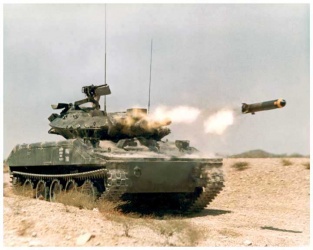
Anti-tank Guided Missile (ATGM), or simply anti-tank missile, refers to a missile system specialized in destroying heavily armoured vehicles such as tanks.
General Info
The advent of anti-tank missiles in War Thunder started in Update 1.59 "Flaming Arrows" with the introduction of various of vehicles mounting an anti-tank missile. Each country received one, and additional were added in future updates. Most are available through unlocks, with the British Strv-81 being premium.
Rockets vs. Missiles
The defining terms between a "rocket" and a "missile" is the presence of a guidance system on the warhead. A rocket flies by its trajectory and once released, is free to fall wherever it lands. A missile on the other hand has access to computer technology to send the guided warhead wherever the operator desires with the usage of a joystick or a laser sight.
Usage of ATGM in-game
In Arcade Mode, all ATGM launchers use the second-generation guidance system. Thus, once fired, keep the cross hair on the desired target to lead the missile. Keep in mind the missile trajectory as it has a very sensitive fuse so make sure it does not prematurely explode on a piece from the environment.
In Realistic and Simulator Modes, missile systems use the guidance system they are equipped with in real life. Thus, first and second-generation of the guidance system exist in-game. First generation guidance system require input from the tank movement keys to manually guide the missiles to the target. This guidance system is very jittery and is not very accurate.
Guidance System
- First-Generation: Also known as MCLOS, this missile requires manual input from the controller to control it. Use the default movement keys WASD to move the missile. A to steer left, D to steer right, W to steer down and S to steer up. Note that while you are controlling the missile, you will not be able to move from your firing position so make sure you are in a safe place.
- Second-Generation: Also known as SACLOS, this is a lot simpler than MCLOS. The missile is automatically guided by your crosshair sights and will adjust accordingly if you move your aiming reticle, so your vehicle is no longer forced to stand in place after firing the missile. So hold your crosshair onto your target as the missile flies into the air to score a hit. Alternatively, you can override the automatic system by aiming at something the missile has already passed to control the missile manually with your crosshair movement. This allows the vehicle to aim the missile at targets it cannot see.
Vehicles able to be equipped with ATGMs
Different launch methods
Every nation had their own big idea of what ATGM equipped vehicle must be able to do, and as such, different vehicle designs were created, some being more specialized, than the others. Here is a list of certain specializations, that are currently in the game:
- Direct attack launchers: These ATGM are standard and are fired straight out the launch tubes. These can be seen as supplementary weapons (such as on the Warrior) or as dedicated ATGM-launching vehicles (such as the RakJPz 2). Missile characteristics are quite diverse in this attack method, but usually possess very high launch speed, penetration values and/or post-penetration damage, though how much better would depend in the launcher vehicle's position in the matchmaking. However, the dedicated ATGM vehicles tend to have higher range and speed than the rest of its contemporaries. Some dedicated launchers even have design perks in term of optic and missile placement being higher than the hull body to make the most of a hull-down position
- Upward attack launchers: Prior to the development of 3rd-generation missiles, one characteristic burdened on the ATGM users is that to guide the missile, the user must remain exposed to maintain visual target to guide the missile onto target. This leaves the user very vulnerable and open to fire. One solution to this problem was a change in firing method. Instead of firing in a straight trajectory, the missile would have an upward launch motion to clear any obstructions in front, like cover for the vehicle. This can be seen in vehicles like the Strv 81 (Rb.52) and Striker designs, with the missiles aligned upwards to clear any cover protecting the vehicle. These missiles over distance eventually level out back into a straight trajectory, however if the target is close enough before this happens, one may exploit the flight pattern to perform a top-down attack onto the enemy's weaker roof armour and hit the enemy while they're behind cover. Higher generation missiles of this kind are more manoeuvrable, can speed up to acceptable level over time, and use tandem-charge to negate ERA effects.
- Hybrid tank technology: The problem with missiles on vehicles is the inherent specialization the vehicle is required to have to make use of the weapon. As time went, technology became more and more fledged out, and so attempts on merging ATGM and tanks to produce the best of the two types of vehicle as a hybrid. One of the earlier tank hybrids was M551. The idea was to launch ATGM right out of cannon barrel, and then guide it with gunner's optics. As a more modern pieces of technology, these ATGMs are generally the fastest out there and can be launched on move at any speed, and with that they are able to compete with dedicated ATGM launchers, but force longer reload time. In the game, this kind of technology is mostly used by BR 9.0 and higher US and USSR tanks, mainly against hostile close air support and far away targets, attacking which with APFSDS would take too much time. For example: tanks like XM-803 and T-80B can use them to fight against helicopters and lighter vehicles from afar.
History
Initial Start-up
The first guided missile of its kind was created by Nazi Germany with the Ruhrstahl X-4 wire-guided air-to-air missile in 1944.[1] The X-4 lead to the predecessor of the ground-attack missile in the X-7 variant, nicknamed Rotkäppchen ("Red Riding Hood"). Neither of these missiles saw operational service in World War II before it ended. After World War II, the interest in missile stagnated in the Allies except to the French. France was the first to produce an anti-tank missile; named the Nord SS.10 and it was introduced to the export market in 1955.[1] The missile was very successful, procured by America and the Israelis and was cost-effective, costing only £350 per missile. 30,000 missiles were produced by 1962. However, it was far from a perfect missile as it only had a range of 1.6 km and a longer effective range was desired. Later in the 1950s, better missiles were produced in all sides of the Cold War. The French followed up with the SS.11, with upgraded lethality and range. The British adopted the Australian Malkara and the Vickers Vigilant missiles, both respectable weapons of the era. The Soviets developed the 3M6 Shmel (AT-1 Snapper), though it seemed to be inspired from the SS.10 design.[1] All these missiles followed a trend of being portable enough to be used by an infantry crew, yet powerful enough to destroy any tank of the time of introduction, which these missiles succeeded in. However, a problem arose in the guidance systems.
Guidance System
The first missiles that came to be used the first-generation guidance system known as "Manual command to line of sight" (or MCLOS). The missile, once in flight, require the operator use a controller such as a joystick to steer the missile into the target.[1] This was a troublesome system as it requires the operator to keep the missile sight on target while manually inputting the correction to the missile course, which was often not precise enough to allow for accurate aiming. This guidance system also left the operator exposed as the missile took its course, to the point that a counter to it was for tanks to simply bombard the position or kill the operator to disrupt the missile guidance. Most of the early missile systems like the SS.11, Malkara, and Shmel were based on this guidance system.[1]
The second-generation guidance system was the "Semi-automatic command to line of sight" (or SACLOS). Unlike the first generation, this requires the operator to simply keep the missile sights onto the target and the missile will correct itself through radio or wire signals.[1] Another system used in this format was a laser sight or a camera view from the war head for a more direct sighting and aiming. This system was a lot simpler to use than the first generation, though still left the operator stationary and vulnerable. SACLOS made up the majority of missile designs used during later half of the Cold War, from the Soviet 9M14 Malyutka (AT-3 Sagger), the British Swingfire, the American AGM-114 Hellfire, and the BGM-71 TOW.
The third-generation guidance system is the most sophisticated and modern of the missile systems. Using a laser or an IR sight to find a target in any environment, the missile uses a "fire-and-forget" system that allows for the operator to move from his position right after the missile is fired.[1] This missile gives the operator a greater degree of safety than the others and can be found in most modern missile launchers, such as the FGM-148 Javelin in U.S. inventory.
Impact of Missiles to Tank Development
The missiles almost caused a collapse in the tank concept. The idea of the tank is that it would be able to resist and resistance and help the infantry break through the enemy lines. The missiles, however, gives the infantry a massive increase in anti-tank power and can destroy tanks very easily with their HEAT warheads. Tanks are unable to keep up with the more powerful HEAT rounds with their armour as more armour means heavier weight and placing enough armour on a tank to be resistant against the missiles makes them prohibitively heavy. Notable events to the tank development due to missiles is Germany's design of their Leopard 1 and the Soviet's discontinuation of the heavy tank series. The German Leopard 1 was made with minimum armour for increased mobility under the pretext that armour will eventually be outdated by more powerful HEAT rounds. The Soviet's discontinuation of the heavy tanks, logistics aside, was due to their growing vulnerability to the anti-tank missiles and thus, their entire existent as a heavily armoured break through tank is left meaningless if it can be stopped by a simple missile.
Not all is lost though for the armoured forces. Conventional steel armour used since World War II became obsolete with improving tank armament and the missiles, but new armour replaced the old and made the tanks once again a dominant vehicle class on the battlefield. Composite armour, an armour made up of a blend of materials such as metal, plastics, and ceramics, prove to be much more resistant than conventional steel armour. The ammo composite armour excel against are HEAT, which was the primary tank ammunition used at the time and on every missile since. Composite armour gave tanks their main armour advantage back by being able to defend itself against missiles. Another armour that increases the tank's effectiveness in battle is the "explosive reactive armour" (or ERA). ERA uses the power of explosives to disrupt HEAT charges, but later models are able to interfere with any projectiles attempting to penetrate the tank armour. Thus, with these two armour type, tanks remain a dominant force of reckoning on the battlefield.
Of course, with new protection, comes new ways of destroying that protection. Missile designers use a variety of ways to defeat the new armour such as the tandem-charge, which uses two HEAT rounds in one missile by using the first one to destroy the protection above the base armour like ERA and the second will attack the base armour straight-on. In response, ways to fight missiles by disrupting their guidance system also began such as electronic jammers, active protection systems, and smoke screens. Nevertheless, the missiles remain a large threat against armoured forces as it gives the infantry a cheap weapon able to destroy an expensive tank.
Media
- Images
- Videos
See also
External links
- [Devblog] Missile Science: new physics with line-of-sight guidance missiles
- [Wikipedia] Anti-tank guided missile
References
- Citations
- Bibliography
- Hogg, Ian V. Tank Killing: Anti-tank Warfare by Men and Machines. London: Sidgwick & Jackson, 1996. Print.


